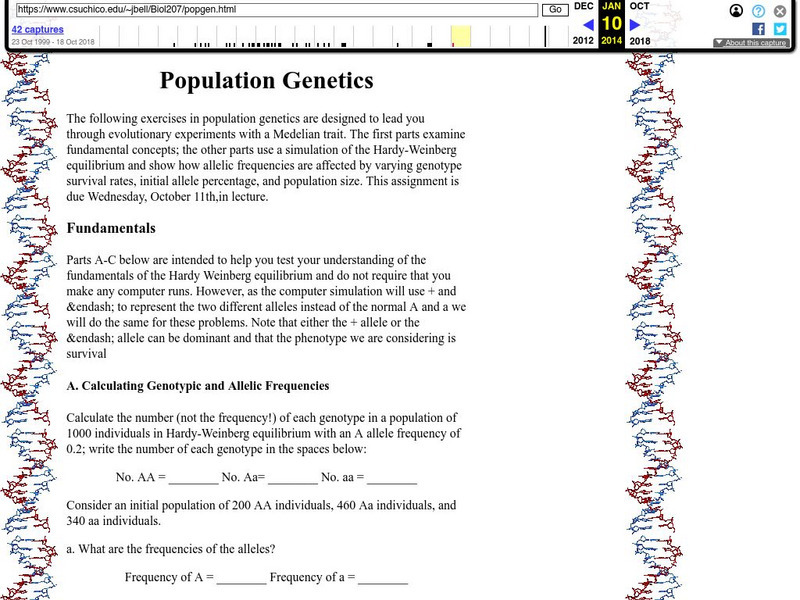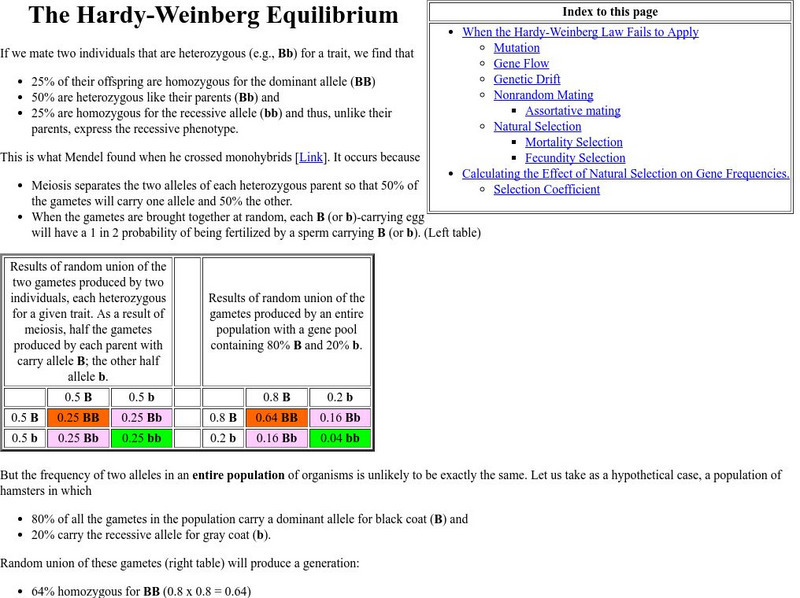Other
Biology Simulations: Population Genetics
Population genetics is the study of genetic variation in populations. This simulation allows the user to observe the frequencies of two alleles over time.
California State University
Csu Chico: Population Genetics
This is a group of Mendelian Genetics exercises that are designed to show the evolution of a trait within a population. The site covers instruction in calculating genotypic and allelic frequencies, determining dominance, the...
PBS
Pbs Learning Media: Genetic Variation
This video segment from NOVA: "Cracking the Code of Life" explores the genetic similarities and differences among organisms.
BiologyWise
Biology Wise: Genetic Drift vs. Gene Flow vs. Natural Selection
Explains what genetic drift, gene flow, and natural selection are, and compares their differences, two at a time.
BiologyWise
Biology Wise: Genetic Mutations in Humans
Discusses common mutations that occur in the human population and describes the many different types of genetic mutations and their impact.
Biology Pages
Kimball's Biology Pages: Hardy Weinberg Equilibrium
Discusses conditions needed for the Hardy-Weinberg Law to hold true and demonstrates calculations involving allelic frequencies to illustrate this principle.
National Health Museum
Nhm: Amino Acid Sequences Show Evolution
This lesson plan focuses on differences in the amino acid sequence of hemoglobin and myoglobin proteins. They use the number of differences to create a phylogenetic tree.
Estrella Mountain Community College
Online Biology Book: The Modern View of Evolution
Take a closer look into the modern view of evolution. This article includes many pieces of evidence, all which support the theory of evolution.
TED Talks
Ted: Ted Ed: Why Are Some People Left Handed?
Today, about one-tenth of the world's population are southpaws. Why are such a small proportion of people left-handed -- and why does the trait exist in the first place? The following video investigates how the uneven ratio of lefties...
PBS
Pbs Teachers: Nordic Sagas: Iceland Genes
Explain how the isolated and homegeneous population of Iceland makes research in family ancestry simpler than in other cultures. Investigate the work of genealogists, and trace your own heritage as far as you can without extensive research.
BiologyWise
Biology Wise: Crossing Over and Why Is It Important in Meiosis?
Explains what meiosis is and what happens during crossing over where genetic material is exchanged between chromosomes. This process is important for ensuring that there is lots of genetic variation in a population as it improves survival.
Cosmo Learning
Cosmo Learning: Principles of Evolution, Ecology and Behavior
A collection of video lectures introducing beginning biology students to the principles of evolution, ecology, and behavior. The course was taught three times a week for a semester at Yale University. The course discusses concepts of...
National Health Museum
Access Excellence: Hardy Weinberg Equilibrium
This site explores what Hardy-Weinberg Equilibrium is, and how teachers can explore this topic in their classrooms. Content includes background information on this topic, as well as numerous learning activities.
Palomar Community College District
Palomar College: Gene Flow
This site from Palomar college explains what gene flow is and describes a situation where this occurs in humans. Information is brief but factual.
PBS
Pbs: How Does Evolution Work?: Breeding Bunnies
This resource provides directions for a lab in which students observe changes in a gene pool of bunnies affected by natural selection. Includes PDF resources.
Howard Hughes Medical Institute
Hhmi: Biointeractive: Schooling Behavior Stickleback Fish From Different Habitats
A team of scientists studied the schooling behavior of threespine stickleback fish by experimentally testing how individual fish responded to an artificial fish school model.
Concord Consortium
Concord Consortium: Evolution: Variations and Adaptations
Students discover that variation in plants allows some varieties to survive in near-drought conditions. Next, students learn that different types of rabbits prefer to eat different varieties of plants. Students make the connection...
Other popular searches
- Population Genetics 11 Grade
- Population Genetics Bunnies
- Population Genetics Lab
- Population Genetics Rabbit








